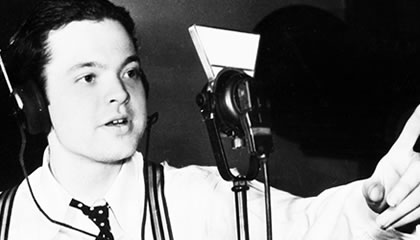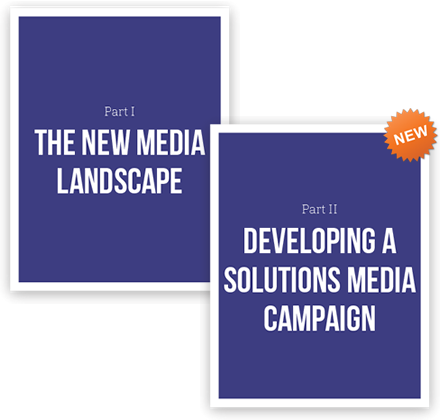Thanks so much for your interest in reading our report: “The Ripple Effect: How to Use the Media for Social Change.”
Some of you have already read Part I: The New Media Landscape; while others are seeing this for the first time. Either way, the entire report is now ready! Part II: Developing A Solutions Media Campaign, is loaded with practical tips for how to be heard above the noise, reach target audiences, and measure the impact of your work. Plus we intersperse lots of Ripple case studies to illustrate our points.
Read brief excerpts from our newly-completed report: How to Use the Media for Social Change, below:
On October 30, 1938, a young actor named Orson Welles read aloud the classic novel War of the Worlds by H.G. Wells on a radio drama show, and many people in the audience interpreted the story as if it were a factual news bulletin. Listeners nationwide sat glued to their radios, convinced that Martians were invading. As the broadcast went on, panicked citizens called their local police and news stations, wondering what to do next. The audience was gripped, and when, at the end of the hour, Welles announced that the story was fictitious, the true lesson of this event was revealed: the right story, told at the right time, by the right person, using the right technology, has the potential to quickly influence critical masses of people.

On the Internet, every website, comment box, and like button can be visualized as a cobblestone in the global town square. And the platforms and codes that enable interactive sites on the Internet are the mortar–the glue that holds the square together–creating a virtual space in place of a physical one, whereby all activities from the extraordinary to the mundane can take place in real time. Social media is, without question, a powerful medium that is constantly influencing the way we share information and communicate with one another. However, it is not the only force to consider when thinking about ways to spread ideas to a larger audience. Video did not kill the radio star, and Facebook will not kill the New York Times.

News production is changing as the blending of social and traditional media becomes more formalized. Journalists and editors incorporate robust social media strategies into every step of their news making process, from sourcing stories to circulating articles. It’s commonplace for entire news teams to scour the Internet, looking for specific keywords, hashtags, images, and influencers, oftentimes verifying their findings by contacting eyewitnesses via Twitter and Facebook. In the spirit of keeping journalistic integrity alive, media outlets often compete to establish authority by being the first to confirm or debunk viral rumors or images. Many reporters, who are already short on time, are forced to focus increasingly on generating traffic for their articles, rather than writing the next groundbreaking exposé.

People crave authority; they want to know where to look when issues are unclear, and information is either too sparse or too abundant. And like it or not, the media capitalizes on this innate human desire, signaling to viewers that something is credible, well-researched, or factual by attaching familiar faces and names to the stories they produce. Traditional outlets are still viewed as sources of authoritative content, while social media acts as an aggregator–a series of impressions and opinions–rather than a collection of reliable facts. In order to create buzz–which is what sustains social media platforms–there must be something to create a buzz about. And as long as the demand for original and authoritative content exists, traditional outlets will remain in business to satisfy it.

A generation ago, people relied on just a few media sources. Whether it was Walter Cronkite, Barbara Walters, or the local news, there were only a handful of news stories, a sprinkling of public service announcements, and a fixed number of advertisements. With this limited number of voices, it was relatively easy to have the power to influence the thoughts and actions of audiences. Today’s media landscape is a deluge of voices and content. Organizations and entrepreneurs must learn how to strengthen their signals to be heard through the noise. We’ve learned that to amplify your voice and to foster the trust necessary to compel action, you need to establish authority. In this section, we share some of our secrets for doing just that.

Obviously, the more people are talking about you (in a positive way), the better, and igniting conversations should be a goal in any media or content marketing campaign. Our work is based on the AIDA conversion funnel, which stands for: Awareness, Interest, Desire and Action. While many PR agencies focus on the top of the funnel – awareness – we see it differently. The real work happens after a reporter writes a story. Organizations and companies need to know what to do with their media coverage: how to parlay the story into conversations, and ultimately, action.

People always ask us how we measure the success of a campaign, and our answer is simple: there is no standard formula for how to do it. Clearly it’s important to have concrete, measurable goals, and reaching them should be one measure of success. But social change takes time, as does building a business, or raising awareness about an issue. Subscribing to the short-sighted, volatile metrics that permeate so much of the digital media world can be both misleading and self-defeating. That said, it is possible to establish some benchmarks and key performance indicators to guide your strategy. This section reviews some ways to measure impact, including: Advertising Value Equivalents, reach and impressions, likes/followers/fans, clicktivism, and influencer marketing.

If you’re trying to further your organization’s mission, or to grow your business, you’ll need continuously to refine and repeat your media campaigns and to adapt to the changing landscape of content marketing and social media along the way. Every campaign will teach you something about target audiences, messaging, and even yourself. In the dynamic world of digital media, there’s always more to learn in order to keep up with best practices, tactics and trends. In this section we discuss a few key concepts to remember as you ideate and assess, including: embracing experimentation, maintaining a steady drumbeat, and keeping your ears to the Internet.

We hope this report ignites the same spark in you that lights us up each time we take on a new project. And we hope you’ll give us a call when you want to make an impact together.
Thanks for reading!

